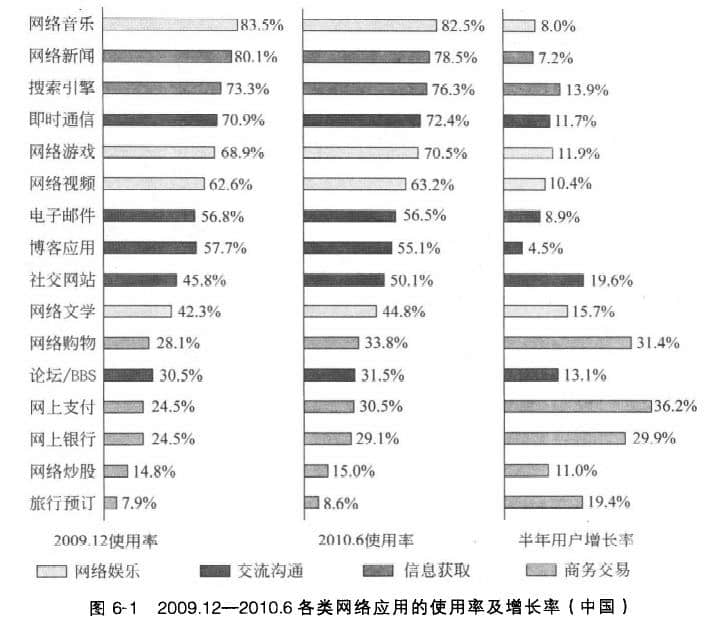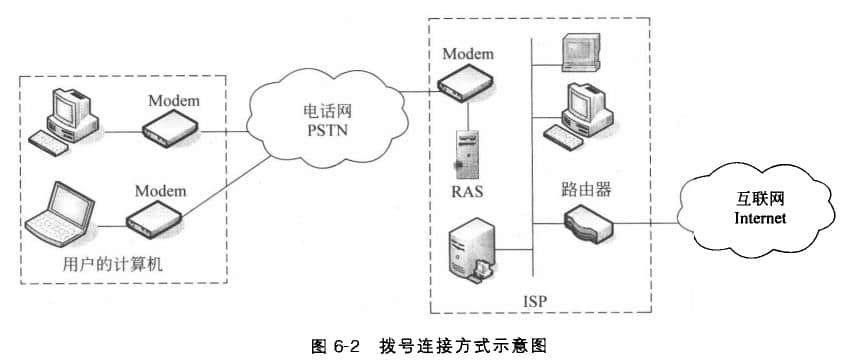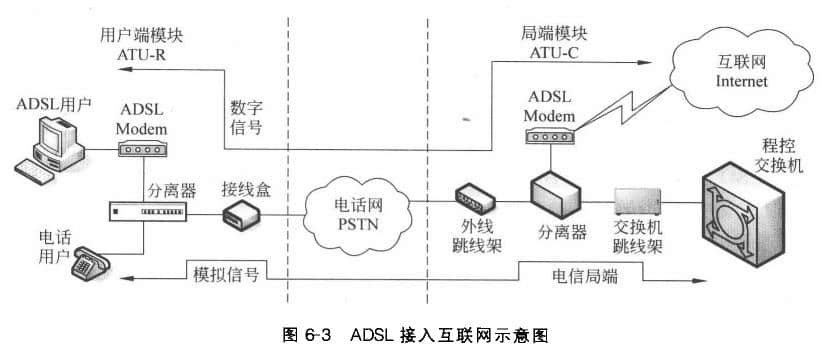Principle of networking
Source: Shangpin China |
Type: website encyclopedia |
Time: June 16, 2014
The Internet connects computers distributed around the world, and names each computer according to unified rules. The network protocol TCP/IP is used to coordinate the information exchange between computers on the Internet. Anyone and any group can join the Internet. Opening to users and service providers is an important reason for the success of the Internet. According to the statistical report released by the China Internet Network Information Center (CNNIC) in July 2010, China had 420 million Internet users by the end of June 2010. With the rapid development of the Internet, keeping online has become a way of work and life for many people Website production The statistics of various network applications are shown in Figure 6-1. At present, people use a variety of ways to connect to the Internet. Different network connection methods require different network devices. 1. Dial up connection When networking through the Public Switched Telephone Network (PSTN), users use Modems to connect with Internet Service Providers (ISPs), and then connect to the Internet through ISPs. This connection is usually called dial-up connection. If you use dial-up connection to access the Internet, you need to install Modem on the local computer. Both the user's computer and the ISP's Remote Access Server (RAS) are connected to the telephone network through Modem. When the user needs to access the Internet, dial a special connection number through the computer connected Modem to establish a connection with the ISP's RAS, and then access the Internet through the ISP's router, as shown in Figure 6-2. Once the connection to the Internet is established, the computer will be "online". When the Internet session is completed and the modem is about to be offline, the modem will "hang up", so the connection will be disconnected until the next dial-up connection. In theory, the speed of dial-up connection can reach 56 kbps. In fact, the speed will decline due to distance, interference and other technical reasons, The actual speed of most dial-up connections is generally 45kbps. 2. Networking through ADSL Networking through ADSL (Asymmetric Digital Subscriber Line) is the most common way for home users to access the Internet at present. It uses the private line or virtual dial-up manet mode, and requires ADSL Modem. The mode of using ADSL to connect to the Internet is shown in Figure 6-3. At the telecommunications office end, the service provider connects the user's telephone line to the special equipment at the office end, The user's original phone number remains unchanged; At the user end, just connect the phone to a separator, and then connect the separator to ADSL Modem with a telephone line. The user computer is connected to ADSL Modem through a network card. At the office end, the subscriber line is connected to ATU-C through the separator and multiplexed through the Digital Subscriber Line Access Multiplexer (DSLAM). A phone call The line can answer and dial calls and transmit data at the same time without affecting each other. Since the traditional telephone line only uses the low frequency band of 0-4kHz: when transmitting voice signals, but in fact the telephone copper line can theoretically transmit the frequency signal of 0-2MH:, ADSL uses the high frequency band above 26kHz:. When using ADSL to access the Internet, ADSL Modem generates three information channels: a standard telephone channel, an uplink channel and a high-speed downlink channel. The uplink rate is 640kbps-1Mbps, and the downlink rate is 1 Mbps-8Mbps. The effective transmission distance range is 3 -'5km. The ADSL system is designed for residential users, After connecting to the Internet, you can enjoy the multimedia services provided by ISP operators, such as on-demand TV, distance learning, telemedicine, home shopping, video phone, multi-party video games, etc. 3. Networking through LAN Connecting to the Internet through LAN is also a common way. The LAN uses a router to connect with the ISP through the data communication network, and then connect to the Internet through the ISP, as shown in Figure 6-4. The user computer needs to install a network interface card (NIC or network card for short). The network card is one of the most important connection devices in the computer LAN. On the one hand, it is responsible for receiving data packets on the network, unpacking them, and transmitting the data to the local processor through the bus on the motherboard; On the other hand, the data on the local computer is packaged and sent to the network. There are many types of data communication networks, such as DDN, ISDN, X. 25, frame relay and ATM networks, which are operated and managed by telecommunications departments. The client is usually a LAN with a certain scale, such as an enterprise network or campus network. 4. Wireless networking There are also many ways to connect to the Internet by wireless, involving a variety of complex technologies. Networking through wireless local area network (WLAN) is a way, that is, based on the traditional LAN, wireless AP (Access Point) and wireless network card are used to build a wireless Internet access mode, which requires the user's PC to be within the coverage of the AP. WiMAX (also known as 802.16 wireless metropolitan area network) is an emerging broadband wireless access technology, which can provide high-speed Internet connection. LMDS (Local Multipoint Distribution Services) is a kind of wireless broadband fixed access network, which is used to transmit voice, data, image and other information in a short distance in both directions. It is also a wireless Internet access method to activate the data function of mobile phones and connect to the Internet through mobile phones or wireless Internet access cards on a PC. The speed is determined by different technologies used, terminal support speed and signal strength. The wireless network card is connected to the wireless WAN, such as China Mobile's TD-SCDMA, China Telecom's CDMA2000, CDMA 1X and China Unicom's WCDMA network. The role and function of the wireless network card is equivalent to the modem in the wired mode. It can connect to the Internet anywhere covered by the wireless telephone signal. WAP (Wireless Application Protocol), the most common protocol for accessing the Internet through mobile phones, is a global network communication protocol. It is based on the HTTP/HTML protocol on the Internet. It is specially designed for communication tools with small display interfaces, low power, small memory, low CPU computing power, and low bandwidth, high latency, and less reliable wireless mobile communication networks. Mobile Internet is an embodiment of mobile Internet, which is an extension and supplement of traditional computer Internet access. The opening of 3G network makes mobile Internet access enter people's life formally.
The user computer needs to install a network interface card (NIC or network card for short). The network card is one of the most important connection devices in the computer LAN. On the one hand, it is responsible for receiving data packets on the network, unpacking them, and transmitting the data to the local processor through the bus on the motherboard; On the other hand, the data on the local computer is packaged and sent to the network. There are many types of data communication networks, such as DDN, ISDN, X. 25, frame relay and ATM networks, which are operated and managed by telecommunications departments. The client is usually a LAN with a certain scale, such as an enterprise network or campus network. 4. Wireless networking There are also many ways to connect to the Internet by wireless, involving a variety of complex technologies. Networking through wireless local area network (WLAN) is a way, that is, based on the traditional LAN, wireless AP (Access Point) and wireless network card are used to build a wireless Internet access mode, which requires the user's PC to be within the coverage of the AP. WiMAX (also known as 802.16 wireless metropolitan area network) is an emerging broadband wireless access technology, which can provide high-speed Internet connection. LMDS (Local Multipoint Distribution Services) is a kind of wireless broadband fixed access network, which is used to transmit voice, data, image and other information in a short distance in both directions. It is also a wireless Internet access method to activate the data function of mobile phones and connect to the Internet through mobile phones or wireless Internet access cards on a PC. The speed is determined by different technologies used, terminal support speed and signal strength. The wireless network card is connected to the wireless WAN, such as China Mobile's TD-SCDMA, China Telecom's CDMA2000, CDMA 1X and China Unicom's WCDMA network. The role and function of the wireless network card is equivalent to the modem in the wired mode. It can connect to the Internet anywhere covered by the wireless telephone signal. WAP (Wireless Application Protocol), the most common protocol for accessing the Internet through mobile phones, is a global network communication protocol. It is based on the HTTP/HTML protocol on the Internet. It is specially designed for communication tools with small display interfaces, low power, small memory, low CPU computing power, and low bandwidth, high latency, and less reliable wireless mobile communication networks. Mobile Internet is an embodiment of mobile Internet, which is an extension and supplement of traditional computer Internet access. The opening of 3G network makes mobile Internet access enter people's life formally.
Source Statement: This article is original or edited by Shangpin China's editors. If it needs to be reproduced, please indicate that it is from Shangpin China. The above contents (including pictures and words) are from the Internet. If there is any infringement, please contact us in time (010-60259772).










